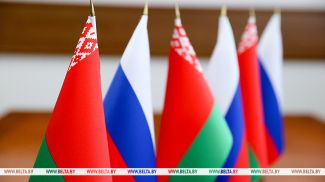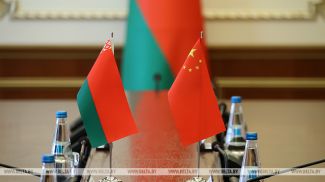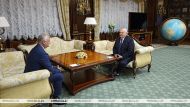MOSCOW, 15 April (BelTA) – Three key principles should become the ideological linchpin of Eurasian integration in the near future. Chairman of the Board of the Eurasian Economic Commission Mikhail Myasnikovich made the statement during the 22nd April International Scientific Conference of HSE University, Russia on 15 April, BelTA has learned.
Mikhail Myasnikovich mentioned trust as the first principle. He said: “It is necessary to build up trust in the Eurasian Economic Union, its institutions and integration processes as a whole among national agencies, entrepreneurs, and members of the general public of the member states. We don't want gaps between the political will and the practical realization. Only unity and unconditional mutual trust of our countries and joint work for the benefit of the population of the member states will secure the successful development of the union.”
Complementarity was mentioned as the second principle. “It is of fundamental importance to make transition from the psychology of competition to the psychology of cooperation,” Mikhail Myasnikovich stressed. “At its heart the economic policy should contribute to the complementarity of the national economies. It is the key to the success of the Eurasian Economic Union. Competition in manufacturing the same product groups is a losing tactic from the very start. The countries should pool efforts and offer merchandise together on the home market and abroad.”
Self-sufficiency is the third principle. “The coronavirus pandemic has demonstrated the vulnerability of the humankind and contradictions between the leading economies,” Mikhail Myasnikovich pointed out. "In order to effectively compete with economic giants smaller economies need to unite and build up institutional cooperation. There is no other alternative. The self-sufficiency of the Eurasian Economic Union, its growing appeal and innovative activity will contribute to the development of the economies of the member states."
The chairman of the Board of the Eurasian Economic Commission stated that 2020 introduced some serious changes into the logic of world development. In his opinion, last year's global economic crisis was prompted by changes in technological paradigms and the world economy system. The pandemic only accelerated negative processes. “The pandemic and the crisis exacerbated a number of other problems, too: growing protectionism and the crisis of the multilateral trade system, unilateral rejection of long-term commitments, the eagerness to move away from the cooperation agenda to the self-dependent development of the world's leading economies,” Mikhail Myasnikovich remarked. “I believe all the mentioned things represent a step backwards. In the evolving situation deeper regional integration and the creation of a renewed architecture of international economic relations on its basis represent one of the most effective ways of development.”
Signed in 2014, the Eurasian Economic Union Treaty is comprehensive: the member states managed to come to an agreement on genuine integration on a broad range of matters at the same time. “The document gave a powerful impulse to the development of integration. The suggested cooperation paradigm has demonstrated its efficiency,” the official was convinced. “In the first five years the Eurasian Economic Union's GDP rose by 21% and was close to $2 trillion in 2019. In the same period the Eurasian Economic Union's industrial output rose by 13.2%, with the output of the processing industry up by nearly 15%. The figures are higher than those, for instance, of the European Union where industrial output rose by 5.4% and the output of the processing industry grew by 6.1%. Mutual trade of the Eurasian Economic Union member states rose by 27.7%. The union is ranked 29th out of 190 economies in the World Bank's annual Doing Business report, an improvement by 12 positions.”
The Eurasian Economic Union has a common merchandise market. Considerable progress has been secured in forming the common services market (it covers 53 sectors). A common Customs Code has been passed. Freedom of movement and social guarantees of working people are secured. For instance, the agreement on pensions came into force in January 2021. As many as 49 common technical regulations have been passed. Over 12,000 international standards are in effect. This is why about 85% of the goods are already certified for compliance with the unified technical norms.
Yet Mikhail Myasnikovich said he believes that the Eurasian Economic Union economies could have developed faster in 2014-2019. The integration potential in the manufacturing sector was not fully realized: there is no orientation for the specialization of economies, the level of manufacturing cooperation is insufficient, the quality and the competitive ability of Eurasian Economic Union goods leave much to be desired. The low level of fixed-capital investments is to blame as well. There was no effective transformation of savings into investments and innovations in the Eurasian Economic Union member states in the past. The investments and innovations are crucial to bolstering the economic potential, Mikhail Myasnikovich said. Another reason is the lack of balance between internal trade and external trade in the Eurasian Economic Union. The export of raw materials plays a major role in the EAEU's foreign trade. In 2020 foreign trade totaled $622.8 billion, with export at $364.4 billion and import at $258.4 billion. Trade inside the union amounted to $54.9 billion in 2020. The ratio is 11 to 1, Mikhail Myasnikovich noted. The poor inclusion of the private sector in integration processes is the last reason. “The private sector has yet to find its place in the Eurasian Economic Union. It does not use integration advantages and does not create new transnational value chains,” he explained.













